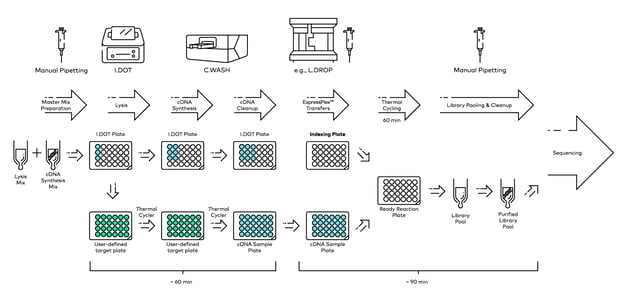Higher reproducibility, reduced cost, and faster processing time with I.DOT Liquid Handler & G.PURE NGS Clean-Up Device.
Next-generation sequencing platforms are powerful technologies, providing gigabases of genetic information in a single run. An important prerequisite for high-throughput DNA sequencing is the development of robust and cost-effective protocols for DNA sample library construction. One way to improve the quality of your libraries is to optimize your NGS library preparation protocol, which can be challenging, as the process involves multiple steps that can introduce user-user variability and the risk of contamination.
The semi-automated NGS library preparation approach from DISPENDIX holds immense promise in resolving these challenges and pushing the boundaries of innovation.
Discover the implementation of a non-contact low volume dispensing I.DOT Liquid Handler in combination with an innovative magnetic bead washer G.PURE for a semi-automated sample preparation protocol to produce adaptor-ligated fragment libraries. Using an innovative dispensing technology of I.DOT in conjunction with magnetic beads, it is possible to label each library using a unique DNA barcode, which allows multiplex sample processing and sequencing of up to 96- or 384-libraries in a single run. Moreover, utilizing the I.DOT, arbitrary user-defined tagmentation/barcoding reactions can be miniaturized and paired with custom PCR index primers to produce highly multiplexed NGS libraries for pooled sequencing.

To explore the robustness and accuracy of our semi-automated pipeline for NGS library preparation, we applied ExpressPlex™ Library Prep Kit provided by seqWell. This simplest, fastest NGS library prep method is specifically designed for support of automation and flexible reaction volumes, enabling at the same time the combinatorial indexing with high multiplexing capabilities.
Sample processing for next-generation sequencing platforms involves the following steps:
- DNA library preparation, including cell lysis and cDNA synthesis, followed by the cDNA cleanup
- Adaptor ligation, nick-translation- or bridge amplification
- Library pooling & cleanup
- Transfer templated beads onto the instrument for sequencing
Sketched overview of a validated NGS library semi-automated workflow using combination of I.DOT Non-Contact Dispenser & G.PURE NGS Clean-Up Device.
 Sketched overview of a validated NGS library semi-automated workflow using combination of I.DOT & G.PURE.
Sketched overview of a validated NGS library semi-automated workflow using combination of I.DOT & G.PURE.
Considering that steps (2)–(4) can be performed quickly and efficiently in pooled fashion, the step (1) incorporating cDNA synthesis with consequent cleanup, performed manually, is time-consuming and requires highly trained and qualified personnel.
Therefore, our primary motivation was to develop and test the accuracy and robustness of semi-automated protocols for NGS library preparation using I.DOT and G.PURE.